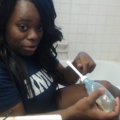What are beef curtains?
Beef curtains is a slang that is used to describe a particularly pronounced vulva. According to Healthline, vulvas, and all their components come in different shapes, sizes, and colors. They even have different smells. Many people worry that their genitalia doesn’t look “normal,” but there really is no normal. The only “normal” out there is what’s normal for you. And unless your normal involves pain or discomfort, everything is likely fine.
Having an enlarged genital is normal and not a cause for concern. Many people are born with large and often asymmetrical labia and experience no negative side effects. Beef curtains can be caused by several factors one of which is a condition known as Childhood asymmetry labium majus enlargement (CALME), in which the outer lips (labia majora) become swollen or enlarged on one side by excess tissue growth, leading to an asymmetrical appearance.
Generally, some people will notice that this structure becomes larger as they go through puberty. Some people will also notice that it grows after pregnancy, while others see changes in their vulva with age. However, beef Curtains can sometimes be a result of trauma. If you’ve ever been sexually or physically abused or have had some other sort of physical trauma to your genitals, it can sometimes result in beef Curtains.
How To Get Rid Of Beef Curtains Without Surgery
Beef curtains is a serious cause for concern in many women not because of its effect on their health but the implication in their relationships and the notion that v- confidence is the root of confidence for women.
Labioplasty, a cosmetic procedure that involves removing excess skin and reshaping the genital to be more symmetrical is usually done by most people to reduce the size of their labia associated with beef curtains. The surgery may cause bruising or swelling in the vulva, as it heals. The vulva will also be very delicate during the healing process. People will need to take extra care to keep the area clean and dry to avoid infections or bleeding.
Surgery always carries risks, such as having a reaction to anesthesia or developing scar tissue. Doctors will discuss these risks and a person’s other options before continuing with any treatment.
In most cases, people do not need treatment for beef curtains. However, if it causes physical, psychological, or mental discomfort, there are non-surgical treatment options that can be employed as follows:
- Diet Changes: The first and foremost step would be to follow a proper good diet that will improve inner muscle strength and thus contribute to better vaginal health. Eating a healthy diet that is high in fiber can help maintain a healthy body weight and also reduces the chances of frequent constipation that can cause the weakening of pelvic muscles which leads to vaginal fat accumulation like in FUPA. The pelvic floor can be strengthened with a strict diet that includes estrogen-rich foods like pomegranates, soybeans, carrots, apples, berries, etc.
- Wardrobe Changes: Wearing loose cotton underwear may help to prevent discomfort around the labia. Some people with beef curtains may notice that their discomfort goes away if they stop wearing tight clothing or underwear. Wearing loose-fitting underwear, shorts, and pants may help prevent unnecessary friction in the area. Wearing natural materials, such as cotton or linen, may also help improve airflow around the vulva. Doctors may also be able to provide women with topical ointments to reduce irritation or manage symptoms.
- Kegel exercises: The feeling of “tightness” during sex is primarily determined by the pelvic floor muscles around the vagina. Kegels are one of the recommended exercises for vagina tightening and beef curtains associated problems. The clench and release exercise is what constitutes the Kegel exercise. Kegel’s exercise is the act of engaging the pelvic floor muscles, holding for 5–10 seconds, and releasing. This is done about 5–10 times in a row, a few times a day. The pelvic floor muscles become stronger because of this and thus help in tightening the vagina.
- ThermiVa: a non-surgical, energy-based treatment offered by ThermiAesthetics has allowed women to get rid of beef curtains without going under the knife. ThermiVa is an in-office, non-surgical procedure that sends controlled thermal energy to the external and internal vaginal tissues. The temperature-controlled radiofrequency system allows physicians to rejuvenate and restore vaginal skin to counteract the effects of childbirth, hormone fluctuation, and aging. The energy conducted during the vaginal rejuvenation treatment promotes collagen remodeling, which helps strengthen the support structures of the vagina. The elasticity of the skin and muscles is increased, while the targeted heat tightens and restores the entire vaginal area. ThermiVa is performed in three separate treatments over a course of three months.
How to Avoid Developing Beef Curtains
It is important to note that every individual’s body is unique and there is no one “ideal” shape or size for the vulva. However, if you are concerned about the appearance or health of your vulva, there are some steps you can take to promote overall vaginal health and potentially reduce the risk of developing a pronounced vulva.
- Practice good hygiene: Keep your vulva clean and dry by gently washing with warm water and mild soap. Avoid using harsh chemicals, perfumes, or douches in the genital area, as these can disrupt the natural balance of vaginal flora and cause irritation or infection.
- Wear comfortable, breathable clothing: Tight-fitting or synthetic fabrics can trap moisture and heat, which can increase the risk of bacterial or fungal infections. Opt for loose-fitting, breathable clothing made from natural fibers like cotton or bamboo.
- Use protection during sex: Condoms and other forms of protection can help reduce the risk of sexually transmitted infections (STIs) that can cause inflammation or irritation in the genital area.
- Practice pelvic floor exercises: Kegel exercises can help strengthen the muscles around the vagina, which can improve overall vaginal health and potentially reduce the risk of developing a pronounced vulva.
- Seek medical advice: If you are experiencing discomfort or changes in the appearance of your vulva, it is important to seek medical advice from a qualified healthcare provider. They can perform a physical exam and provide personalized recommendations for promoting vaginal health and addressing any specific concerns. ALSO SEE: Blue Wafflé Disease





